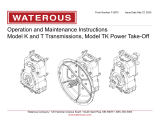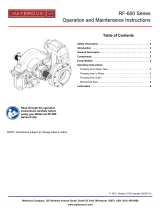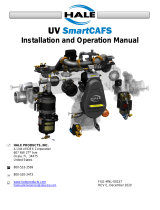Page is loading ...

CPK-5 Series
Operation and Maintenance Instructions
Read through the installation
instructions carefully before using
your Waterous CR/CRU-1/CRU-2 Series Pump
Waterous Company, 125 Hardman Avenue South, South St. Paul, Minnesota 55075 USA (651) 450-5000
www.waterousco.com
F-1031, Section 2126 (Revised: 6/4/20)
NOTE: Instructions subject to change without notice
Table of Contents
Safety Information ....................................................... 2, 3
Introduction ...................................................................... 4
General Description ......................................................... 4
Pump Models ................................................................... 4
Operating Instructions
Pumping from Water Tank ------------------------------------- 5
Pumping from in Relay ----------------------------------------- 6
Pumping from Draft ---------------------------------------------- 7
Mechanical Seal -------------------------------------------------- 8
Fire Hose Testing ------------------------------------------------ 9
Lubrication ..................................................................... 10

F-1031, Section 2126
Page 2 of 10
Scalding Water Hazard. May result in serious
burns.
When operating the pump, be sure to open at least
one discharge valve slightly to prevent the pump from
overheating. If the pump runs for a few minutes com-
pletely closed, it may heat the water enough to scald
someone when the valve is opened. Overheating can
damage the packing, seals and other pump parts. If
the apparatus builder has installed a by-pass system
or other provision designed to prevent overheating,
opening a discharge valve may be unnecessary.
!
WARNING
Pressure Hazard. May result in personal injury.
Prior to connection or removal of hoses, caps or other
closures with pump intake or pump discharge connec-
tions, relieve pressure by opening drains or bleeder
valves. Bleeder valves should also be used while filling
a hose connected to an intake with fluids.
!
WARNING
Unexpected Truck Movement. May result in seri-
ous personal injury or death.
Failure to properly shift transmission in accordance to
the transmission operating instructions may result in
unexpected truck movement which may result in seri-
ous personal injury or death.
!
WARNING
Death or serious personal injury might occur if proper
operating procedures are not followed. The pump op-
erator, as well as individuals connecting supply or dis-
charge hoses to the apparatus must be familiar with
these pump operating instructions as well as other op-
erating instructions and manuals for the apparatus,
water hydraulics and component limitation.
!
WARNING
Safety Information
Read through the safety information and operating instructions carefully before using
your Waterous Pump.

F-1031, Section 2126
WARNING
Hose Testing Hazard. May result in serious personal injury.
Due to a potential for catastrophic hose failure during service testing of fire hose, it is vital that safety precautions be taken to
prevent exposure of anyone to this danger. Fire pumps on fire department apparatus are not designed for and should not be
used for service testing of fire hoses. Hose testing machines should be used for service testing of fire hoses.
WARNING
Pressure Hazard. May result in serious personal injury.
If a fire pump on a fire department apparatus is used for service testing of fire hoses, the procedures in NFPA 1962 MUST be
followed including the use of a fire department gate valve with a ¼-inch (6 mm) hole drilled through the gate installed
between the fire apparatus discharge outlet and the hose test layout to prevent a volume surge from the pump in the event a
hose bursts during testing.
WARNING
Scalding Water Hazard. May result in serious burns.
If a fire pump on a fire department apparatus is used for service testing of fire hoses, pump discharge water must be
circulated through a by-pass system or discharged through a slightly open discharge valve, or some other provision must be
used to prevent overheating. If the pump runs for a few minutes without adequate flow through the pump, water may be
heated enough to scald someone when a valve is opened.
Page 3 of 10
Safety Information
Read through the safety information and operating instructions carefully before using
your Waterous Pump.

F-1031, Section 2126
Page 4 of 10
Introduction
This instruction contains the information needed for operation and maintenance of CPK-5 Series pumps.
General Description
The CPK-5 series pumps are a two-stage pump providing performance of 320 GPM @ 1350 PSI (1211 l/min @ 93 bar).
This pump is designed to run continuously for 30 minutes per NFPA 1901 standard sections regarding ultra-high
pressure fire pumps. Dry run and deadheaded operation are not recommended for this pump. Doing so will permanently
damage the pump.
OPERATION LIMITS: Do not operate pump beyond max. pressure (1350 psi) or max. speed (9400 rpm).
Fail to do that may result in personal injury or premature pump failure.
CPK-5 Series

F-1031, Section 2126
F-1031, Section 2126
Page 5 of 10
Unexpected Truck Movement. May result in per-
sonal injury or death.
Failure to properly shift transmission in accordance
with the transmission operating instructions may re-
sult in unexpected truck movement which may result
in serious personal injury or death.
!
WARNING
Pumping from Tank
!
WARNING
Scalding Water Hazard. May result in serious
burns.
When operating the pump, be sure to open at least
one discharge valve slightly to prevent the pump from
overheating. If the pump runs for a few minutes com-
pletely closed, it may heat the water enough to scald
someone when the valve is opened. Overheating can
damage the packing, seals and other pump parts. If
the apparatus builder has installed a by-pass system
or other provision designed to prevent overheating,
opening a discharge valve may be unnecessary.
CAUTION
Pump cannot be deadheaded for more than 60
seconds. May cause the pump to overheat and
damage the pump.
3.
Set relief valves or other pressure governing de-
vice to desired pressure.
4.
Engage pump drive, accelerate engine to obtain
desired discharge pressure and capacity.
After Pumping
!
WARNING
1.
Open valve(s) in piping between tank and pump in-
take and at least one discharge valve.
2.
Allow about 30 seconds for water to flow into
pump.
Pressure Hazard. May result in personal injury or
death.
Prior to removal of hoses, caps or other closures with
pump intake or pump discharge connections, relieve
pressure by opening drains.
1.
Disengage pump drive.
2.
If pumping anything but clean water, remove all in-
take and discharge caps, open all valves and open
all drains. Flush entire system with clean, fresh wa-
ter for several minutes to remove all traces of im-
purities.
3.
Close all drains and install intake and discharge
caps.
CAUTION
Do not attempt to pump more water than is availa-
ble from the tank. Always make sure the intake
pressure compound gage reading stays above
zero.
Pressure Hazard. May result in personal injury or
death.
Prior to connection of hoses, caps or other closures
with pump intake or pump discharge connections, re-
lieve pressure by opening drains.
!
WARNING
Operating Instructions
NOTICE

F-1031, Section 2126
F-1031, Section 2126
Page 6 of 10
Scalding Water Hazard. May result in serious
burns.
When operating the pump, be sure to open at least
one discharge valve slightly to prevent the pump from
overheating. If the pump runs even for a few minutes
completely closed it may heat the water enough to
scald someone when the valve is opened. Overheat-
ing can damage the packing, seals and other pump
parts.If the apparatus builder has installed a by-pass
system or other provision designed to prevent over-
heating, opening a discharge valve may be unneces-
sary.
!
WARNING
Unexpected Truck Movement. May result in per-
sonal injury or death.
Failure to properly shift transmission in accordance
with the transmission operating instructions may result
in unexpected truck movement which may result in se-
rious personal injury or death.
!
WARNING
Pumping in Relay
CAUTION
Pump cannot be deadheaded for more than 60
seconds. May
cause the pump to overheat and
damage the
pump.
NOTE: Some fire departments operate at a mini-
mum intake pressure of 10 psi (.7 bar) when pump-
ing in relay to prevent a “soft” intake hose from col-
lapsing.
After Pumping
1.
Open intake and other valves as necessary to
allow water or fuel to enter the pump.
NOTE: Bleeder valves should be used while filling
a hose connected to an intake with water.
CAUTION
Limit intake pressure to 75 psi (5.2 bar) if possible.
Although the pump will operate properly with higher
intake pressure, such operation will greatly acceler-
ate mechanical seal wear.
2.
Open discharge valves and accelerate engine to
obtain desired discharge pressure and capacity.
3.
Set relief valves or other pressure governing de-
vice to desired pressure.
4.
Disengage pump drive.
5.
If pumping anything but clean water, remove all in-
take and discharge caps, open all valves and open
all drains. Flush entire system with clean, fresh wa-
ter for several minutes to remove all traces of im-
purities.
6.
If pump is kept full of water when not in use, make
sure water is clean and non-corrosive. Make sure
the pump is completely full or completely drained
(never partially full).
7.
Close all drains and install intake and discharge
caps.
8.
If truck is equipped with a priming pump, operate it
until fluid is discharged from priming pump dis-
charge pipe. If equipped with a priming tank, check
fluid level and refill if necessary.
CAUTION
Pressure Hazard. May result in personal injury or
death.
Prior to removal of hoses, caps or other closures with
pump intake or pump discharge connections, relieve
pressure by opening drains or bleeder valves.
!
WARNING
CAUTION
Do not attempt to pump more water than is avail-
able from the hydrant or relaying pumper. Always
make sure the intake pressure compound gage
reading stays above zero.
Pressure Hazard. May result in personal injury or
death.
Prior to connection of hoses, caps or other closures
with pump intake or pump discharge connections, re-
lieve pressure by opening drains or bleeder valves.
!
WARNING
NOTICE
NOTICE
NOTICE
NOTICE

F-1031, Section 2126
F-1031, Section 2126
Page 7 of 10
Pressure Hazard. May result in personal injury or
death.
Prior to connection of hoses, caps or other closures
with pump intake or pump discharge connections, re-
lieve pressure by opening drains.
!
WARNING
Scalding Water Hazard. May result in serious
burns.
When operating the pump, be sure to open at least
one discharge valve slightly to prevent the pump from
overheating. If the pump runs even for a few minutes
completely closed it may heat the water enough to
scald someone when the valve is opened. Overheat-
ing can damage the packing, seals and other pump
parts. If the apparatus builder has installed a by-pass
system or other provision designed to prevent over-
heating, opening a discharge valve may be unneces-
sary.
!
WARNING
Pressure Hazard. May result in personal injury or
death.
Prior to removal of hoses, caps or other closures with
pump intake or pump discharge connections, relieve
pressure by opening drains.
!
WARNING
Pumping from Draft
e) Make sure intake strainer is far enough from bot-
tom to prevent sand, gravel and other foreign mat-
ter from being drawn into the pump.
1.
Engage pump.
2.
Prime the pump (see separate instructions supplied
with primer).
3.
Open discharge Valves, and accelerate engine to
obtain desired discharge pressure and capacity.
4.
Set relief valves or other pressure governing device
to desired pressure.
After Pumping
!
WARNING
Unexpected Truck Movement. May result in per-
sonal injury or death.
Failure to properly shift transmission in accordance
with the transmission operating instructions may result
in unexpected truck movement which may result in se-
rious personal injury or death.
NOTE: To get full capacity, quick prime and maintain
pump efficiency:
a)
Position vehicle as near as possible to water sup-
ply.
b)
Avoid humps and sharp bends in intake hose.
Make sure no part of hose is higher than pump in-
let. (Air pockets in intake hose may cause loss of
prime or erratic pump action, and may reduce
pump capacity.)
c)
Make sure all intake connections are tight and dis-
charge valves are closed.
d)
Immerse intake strainer at least two feet below wa-
ter or fuel surface to prevent pump from drawing
air. (Whirlpools forming above intake strainer indi-
cate that strainer is too close to surface of water.)
1.
Disengage pump drive.
2.
If pumping anything but clean water, remove all in-
take and discharge caps, open all valves and open
all drains. Flush entire system with clean, fresh water
for several minutes to remove all traces of impurities.
3.
Close all drains and install intake and discharge
caps.
CAUTION
Freezing water hazard.
May cause damage to the pump.
If the pump is exposed to freezing temperatures,
drain all water from pump, lines and accessories.
CAUTION
Pump cannot be deadheaded for more than 60
seconds. May cause the pump to overheat and
damage the pump.
NOTICE
NOTICE

F-1031, Section 2126
Page 8 of 10
Mechanical Seal
A mechanical shaft seal is used and no adjustment is re-
quired. When the pump operates, the water being
pumped cools and lubricates the shaft seal to prevent it
from overheating.
If the mechanical seal leaks, replace the entire seal.
CAUTION
Prolonged dry pump operation or operating a dry
pump at high speeds will reduce the life of the me-
chanical seal.
NOTICE

F-1031, Section 2126
Page 9 of 10
Fire Hose Testing
WARNING
Hose Testing Hazard. May result in serious personal injury.
Due to a potential for catastrophic hose failure during service testing of fire hose, it is vital that safety precautions be taken
to prevent exposure of anyone to this danger. Fire pumps on fire department apparatus are not designed for and should not
be used for service testing of fire hoses. Hose testing machines should be used for service testing of fire hoses.
NFPA 1962 Standard for the Inspection, Care, and use of Fire Hose, Couplings, and Nozzles and the Service Testing of Fire
Hose provides requirements and testing procedures for service-testing fire hose at least annually. NFPA 1962 includes
procedures for service testing with either a hose testing machine or with a pump on a fire department fire apparatus.
WARNING
Pressure Hazard. May result in serious personal injury.
If a fire pump on a fire department apparatus is used for service testing of fire hoses, the procedures in NFPA 1962 MUST
be followed including the use of a fire department gate valve with a ¼-inch (6 mm) hole drilled through the gate installed
between the fire apparatus discharge outlet and the hose test layout to prevent a volume surge from the pump in the event a
hose bursts during testing.
During fire hose testing with a fire pump on a fire department fire apparatus, the fire pump is required to be operated at high
discharge pressure with little or no flow out of the apparatus.
WARNING
Scalding Water Hazard. May result in serious burns.
If a fire pump on a fire department apparatus is used for service testing of fire hoses, pump discharge water must be
circulated through a by-pass system or discharged through a slightly open discharge valve, or some other provision must be
used to prevent overheating. If the pump runs for a few minutes without adequate flow through the pump, water may be
heated enough to scald someone when a valve is opened.
CAUTION
If a fire pump on a fire department apparatus is used for service testing of fire hoses, operating the pump at high discharge
pressure with little or no flow may result in severe damage to the pump.
NOTICE

F-1031, Section 2126
Page 10 of 10
CAUTION
Low or excessive lubrication fluid may cause
damage.
If lubricant fluid level is low, locate source of leak
and repair. If level is high, loosen oil level plug
and drain until proper level is reached. If any wa-
ter drains out, change lubrication fluid and deter-
mine source of water leakage and repair.
Lubrication
1.
Check the lubrication fluid level monthly by
checking the sight plug or by removing the oil
level plug. The fluid should be level with the
bottom of the oil level hole.
2.
Change lubrication fluid and clean breather
once a year or after each 100 hours of
operation, whichever comes first.
Lubrication fluid
may be added through the
oil level hole or by
removing the breather and
adding fluid through
the opening. Synthetic
gear lube should be
used.
3.
Quantities of lubrication fluid if system is com-
pletely drained and refilled:
K Series Transmission
Gear lube spec: 75W-90 full synthetic.
Capacity:
Inverted mounting: 1.2 quarts
Horizontal mounting: 1.5 quarts
Vertical mounting; 1.6 quarts
(Capacity measurements are approximate and
include the transmission, oil cooler, and oil pump.
Hoses and fittings are not included. Adjust
accordingly to application).
Oil fill procedure:
1. With oil level plug installed, fill transmission
with 1.5 quarts of gear lube.
2. Run electric oil pump for 1 minute.
3. Stop oil pump.
4. Remove oil level plug.
5. Drain excess oil or add oil until a small
stream of oil runs out oil level hole.
6. Install oil level plug.
7. Repeat steps 2-6 until no additional oil is
required.
NOTICE
/













